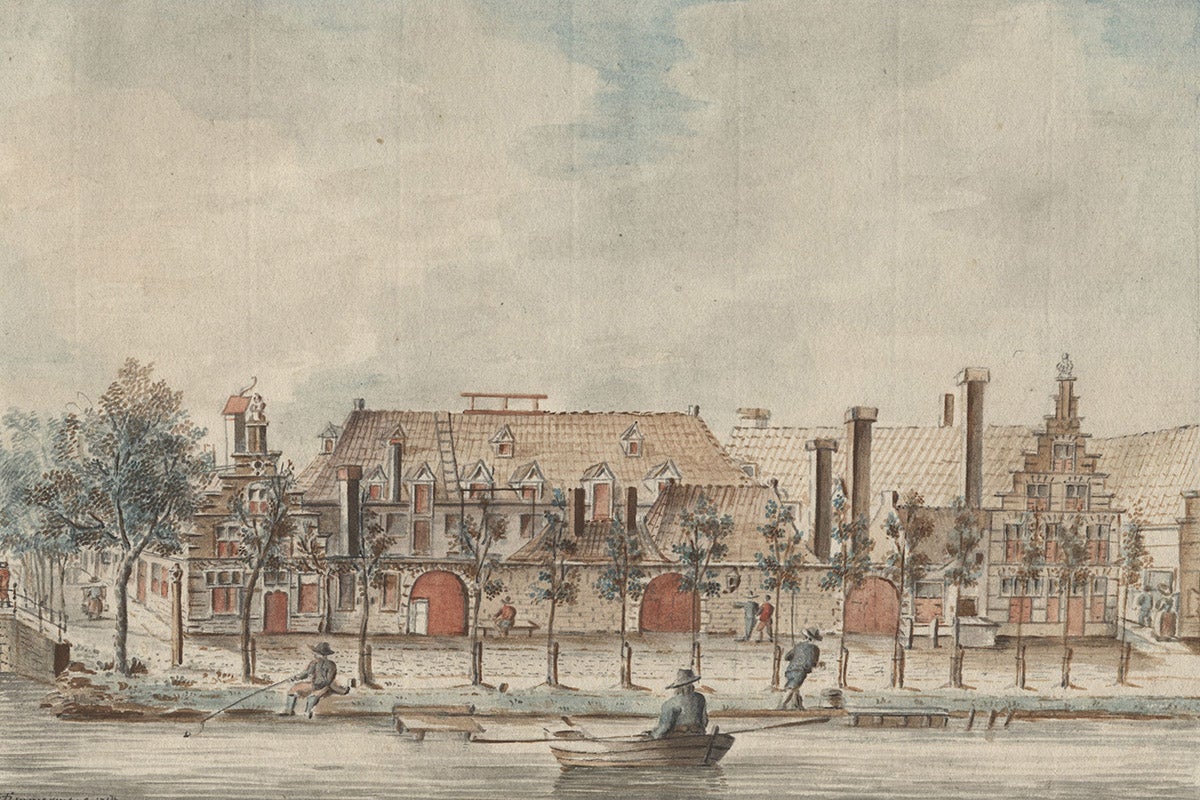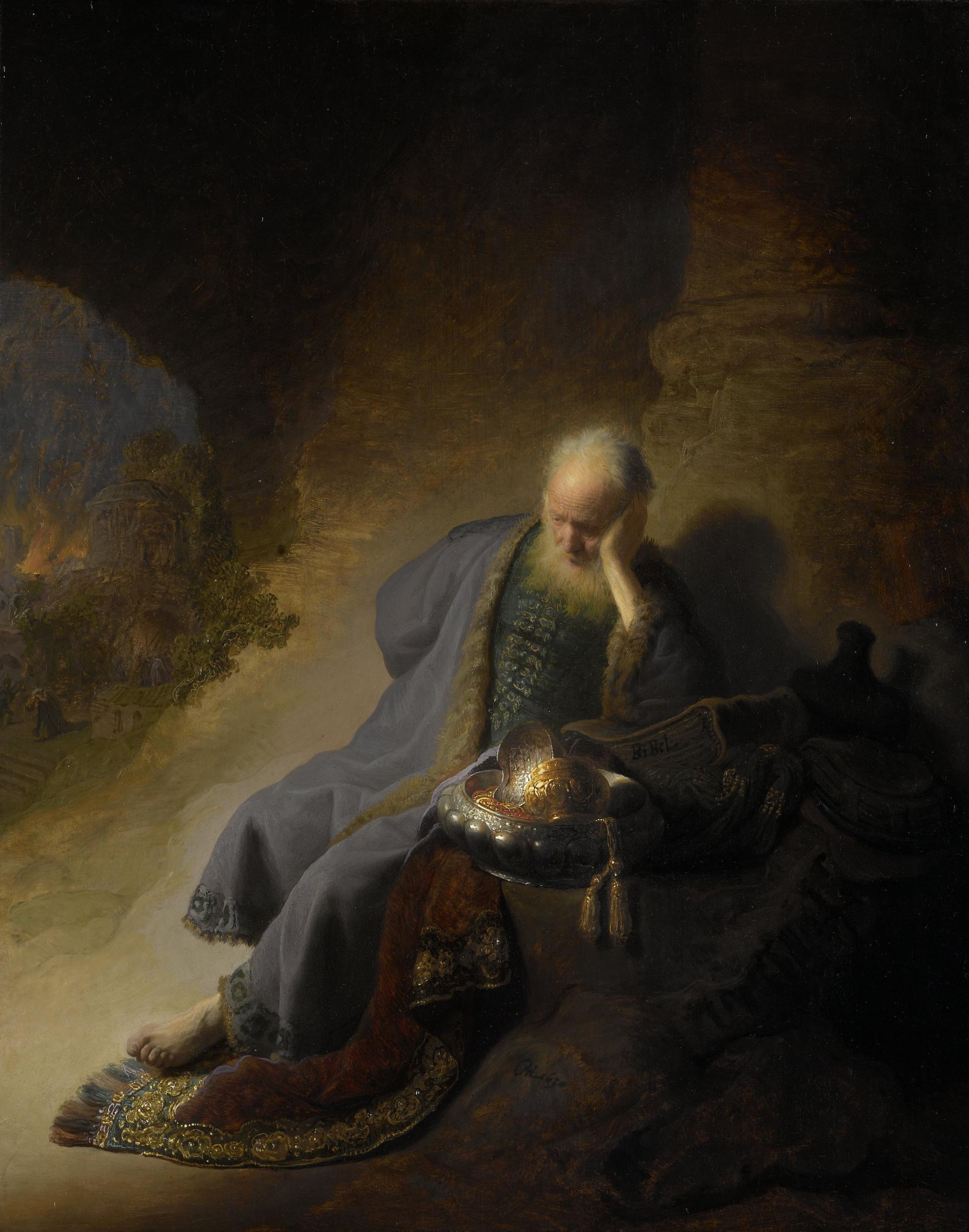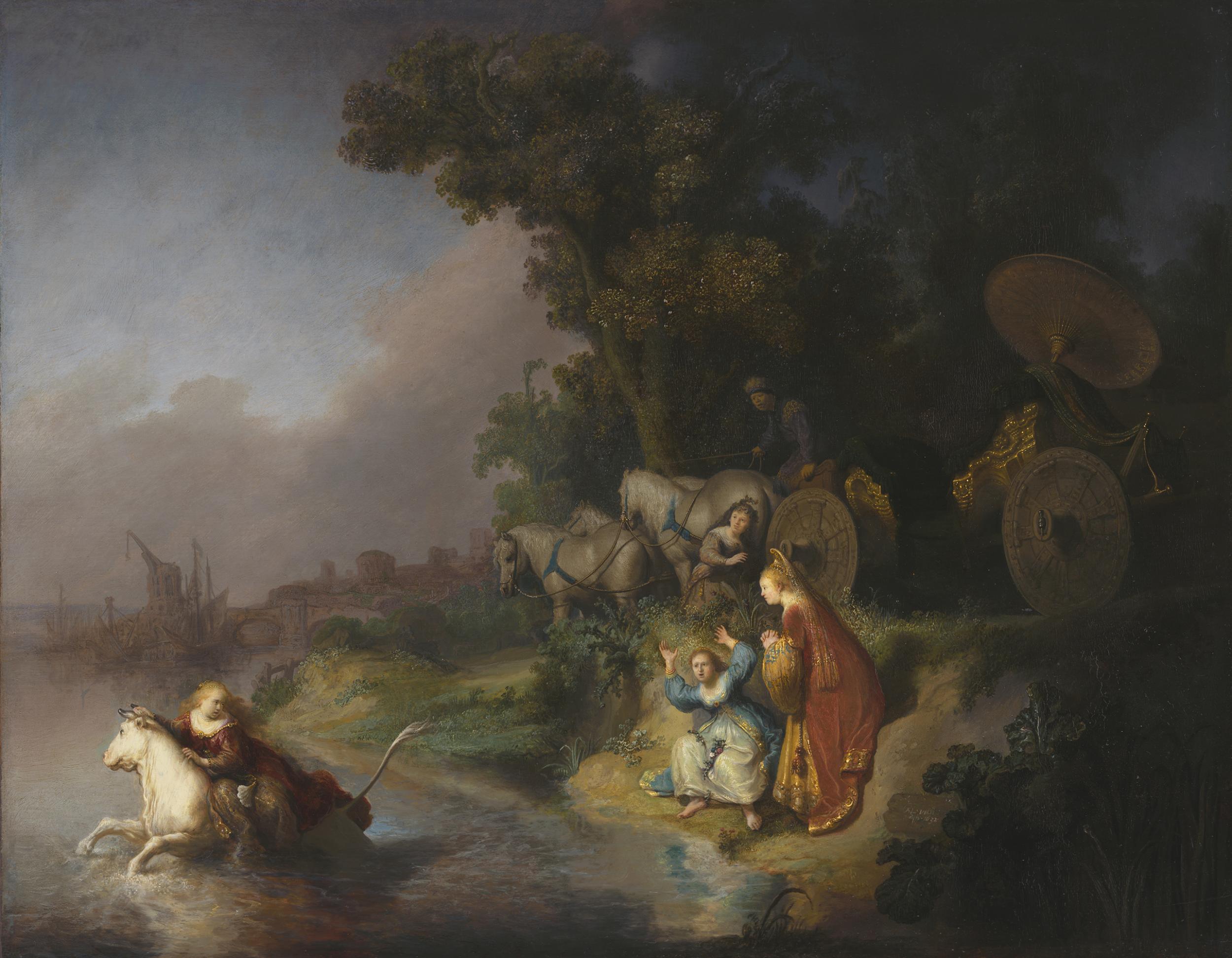Rembrandt’s genius was no overnight success. He worked hard to get it right
His early work was 'feeble' and he wasn't even the best painter in his home town. But he possessed an incredible ability to depict complex emotions in his work. Perhaps, suggests William Cook, that is why Rembrandt took so long to get going


In the Lakenhal Museum in Leiden, an ancient university town about 30 miles from Amsterdam, there’s a stiff and stilted painting of a bunch of posh blokes in fancy dress. If it was by any other artist it wouldn’t attract a second glance, but among the crowd of faces in the background there’s a young man who looks strangely familiar – an unkempt youth with a bulbous nose and a mop of curly hair. This face in the crowd is a surreptitious self-portrait, the earliest self-portrait by the greatest portrait painter who ever lived.
Ask anyone where Rembrandt came from, and chances are they’ll say Amsterdam – the city where he made his name. However, the place where he was born and raised and learnt his craft was Leiden, and now his historic hometown is staging the first show ever devoted to his early years. Young Rembrandt is a fascinating survey – the story of a tyro artist struggling to find his feet. At the start of this show his paintings feel forced and diffident. By the end of the show, 10 years later, they’re full of life. But it’s not just these later masterworks which catch the eye – it’s also his awkward apprentice works. What’s so intriguing about Rembrandt (and so heartening for the rest of us) is that his immense talent took so long to bloom.
“For me, what is so remarkable is in some sense how – how can I say this about Rembrandt – how feeble the early pictures are,’’ says Christopher Brown, the co-curator of this Anglo-Dutch exhibition. “Had he died after those first few pictures, we would have no interest in him at all.’’
This exhibition, which transfers to Oxford’s Ashmolean Museum in February, sheds fresh light on the early life of one of the greatest painters of all time. It shows talent is never instantaneous, that it needs the right conditions – above all, the right time and the right place – in which to thrive.
“There’s this cliché about Rembrandt – namely, that he was a poor boy from a poor background who suddenly became the most important painter in the world,’’ says Onno Blom, the Dutch author of a new book about the artist, also called Young Rembrandt. ‘”This is not true.’’ Numerous factors contributed to his eventual success, above all his upbringing in early 17th Leiden – the place, as Blom puts it, “where Rembrandt became Rembrandt.’’
Rembrandt van Rijn was born in Leiden in 1606, the youngest son of a local miller. Biographers are often tempted to play up Rembrandt’s working-class credentials, but although his father was no aristocrat he was fairly prosperous. As well as milling malt for the local brewery (more lucrative than milling corn) he also ventured into real estate, building several houses here in Leiden and renting them out at a tidy profit. He had the money (and the social status) to send Rembrandt to the local Latin School – a kind of grammar school for sons of the upper and emerging middle classes.
Leiden’s Latin School was a feeder school for Leiden University (Holland’s oldest and most illustrious university) and Rembrandt subsequently became an undergraduate there. Biographers have tended to belittle his student days at the Oxbridge of the Netherlands, claiming he merely enrolled to avoid conscription, or to drink cheap beer in the student bars. However, recent research has revealed that Rembrandt spent a lot longer there than people previously believed – at least two years, rather than just a term or two.
Rembrandt learnt next to nothing about the practice of painting at school or university, but both institutions taught him a great deal about two subjects which would inform his adult oeuvre: the classics and the Bible. If he’d grown up in a one-horse town, and received only a rudimentary education, it’s hard to imagine him painting scenes from classical mythology and the New Testament with such empathy. The classical education he received in Leiden gave his work its intellectual rigour. As curator Christian Vogelaar says: “That does not guarantee a great artist – but it helps.’’

Rembrandt wasn’t just lucky to be born in this particular place. He was also lucky to be born at that particular time. Barely 30 years before, Leiden had been besieged for a whole year by the Spanish, and half its inhabitants had perished. By the time Rembrandt was born, in 1606, Leiden had become a boom town, the site of Holland’s oldest theatre as well as its oldest university, a meeting place for artists, scientists, writers and intellectuals. Had he been born here a generation earlier, there would have been no time for painting. He would have had his work cut out simply trying to stay alive.
Rembrandt left university determined to become an artist. Back then this wasn’t seen as a wayward or eccentric career choice. Rather, it was regarded as a sensible, respectable occupation. He was apprenticed to Jacob Van Swanenburg, a journeyman artist in Leiden, and then to a more accomplished artist called Pieter Lastman in Amsterdam. Yet when the time came to set up on his own, Rembrandt didn’t stay in Amsterdam. Instead he returned to Leiden. In Amsterdam he would have been competing with some of the best painters in Europe, and his paintings simply weren’t good enough – not yet. Here in Leiden, he could be a bigger fish in a smaller pond.

Yet, initially, Rembrandt wasn’t even the best young painter in Leiden. In his late teens and early twenties he shared a studio in Leiden with his boyhood friend Jan Lievens, and for the first few years Lievens far outshone him. While Lievens turned out highly accomplished (and highly marketable) paintings, Rembrandt was still groping in the dark, trying (and often failing) to bring his figures to life.
"We think of him as one of the towering geniuses of the western tradition yet his early years are a struggle,’' says Brown. "This is a very tentative beginning for an artist who was to become such an extraordinary master – one of the great figures in western painting.’'
Rembrandt and Lievens were more or less the same age (Lievens was a year younger) but while Rembrandt was still just starting out, Lievens was already a seasoned pro. Rembrandt had begun his artistic apprenticeship when he was 16, Lievens when he was just eight years old. In those days this wasn’t unusual. It was Rembrandt who was the odd one out. No wonder he was still feeling his way while Lievens had already hit his stride. Lievens had a big head start but Rembrandt eventually surpassed him.

“Rembrandt is superior to Lievens in his sure touch and liveliness of emotions,’’ wrote the Dutch connoisseur Constantijn Huygens, who visited the two young artists in their studio. “Lievens is the greater in inventiveness and audacious themes and forms. Everything his young spirit endeavours to capture must be magnificent and lofty. Rather than depicting his subject in its true size, he chooses a larger scale. Rembrandt, by contrast, devotes all his loving concentration to a small painting, achieving on that modest scale a result that one would seek in vain in the largest pieces of others.’’
Huygens was the first critic to define the quality which made Rembrandt so special: his incredible ability to depict complex emotions in his paintings. It was this depth of feeling which set him apart from Lievens and eventually secured his status as the greatest portraitist of all time. This essential difference is encapsulated in two portraits of Rembrandt in this exhibition: one a self-portrait, the other a portrait by Lievens. The Lievens portrait is self-assured yet unremarkable, the Rembrandt self-portrait is brilliant and bizarre. The face is obscured by shadow, the eyes are barely visible, yet it conveys an intense sense of his personality, and his state of mind.
This, to my mind, is the main reason why Rembrandt took so long to get going. While Lievens was content to represent the appearance of his subjects. Rembrandt looked beyond the surface to capture what they felt and thought. “I can’t help feeling that something of his extraordinary insight into what it is to be human does depend on those early struggles,’’ says Brown. “It was really hard work to get it right.’’
Huygens wasn’t the only connoisseur to notice Rembrandt’s emerging talent. In 1629, an English diplomat called Robert Kerr purchased three paintings by Rembrandt for King Charles I, including a penetrating portrait of the artist’s mother. In 1632, two paintings by Rembrandt were acquired by the Dutch Royal Family. Finally, after 10 years of toil, Rembrandt van Rijn was on his way.

In 1632, Jan Lievens left for England, where he pursued a successful if unexceptional career. In 1634 Rembrandt married his beloved Saskia, the model for some of his finest paintings, and moved to Amsterdam, where he lived until his death, aged 63, in 1669. There’s no doubt that Amsterdam was where he made his greatest artworks. It’s fitting that the city’s Rijksmuseum boasts the best and biggest Rembrandt collection in the world. But to really understand the artist, you have to come to Leiden. It’s here that you get a sense of the world he grew up in, where his character was formed.
So, four centuries since he lived here, what remains of Rembrandt’s original hometown? Well, the Latin School is still there, and so is Van Swanenburgh’s old studio, and St Peter’s Church, where his parents were married – and later buried. His father’s windmill is actually a recent replica, but that doesn’t really matter. It’s built on the same site, in the same style, and so it gives you a pretty good idea of how things must have looked back then.
The house where Rembrandt was born was torn down in 1927, replaced by a row of nondescript modern houses (and a rather strange modern statue) but although this omission makes the tour guides squirm with embarrassment, I reckon it’s no bad thing. If the house was still there it’d be full of all the usual knick-knacks, besieged by tourists taking selfies. To get a measure of the man, you’re far better off simply strolling around town.
By the time Rembrandt left Leiden, its glory days were over. Its lucrative cloth trade collapsed and its creative and intellectual life was riven by religious schisms. Having quadrupled in half a century, Leiden’s population flatlined. There were fewer people living here in 1900 than there were in 1700. Yet with no need to build new houses and no heavy industry to speak of, Leiden’s antique character was preserved.
Today there are more buildings here from the Golden Age (that halcyon period when Holland led the western world in everything from art to commerce – a period that roughly coincided with Rembrandt’s lifetime) than in any other Dutch city apart from Amsterdam. Wandering along its tranquil canals, lined with handsome terraced houses, you could almost be back in the 17th century. Leiden is full of buildings that Rembrandt would have recognised, including the brewery his father supplied with malt and the house where Jan Lievens was raised.
The Lakenhal was built in 1640, a few years after Rembrandt left Leiden. It was a guildhall for a few hundred years before becoming a museum (here in Leiden, a century seems a shortish time). The museum is charming, with a decent collection of Golden Age paintings, but its modest haul of Rembrandts is confined to a few early works.
This exhibition is a rare opportunity to see so many of his early works together, and a unique chance to see them in Leiden, where he painted them. It provides an intimate insight into the evolution of his art. And for anyone who’s struggling to make their mark, in whatever field, it’s reassuring to discover that even if you’re a genius like Rembrandt, there really is no such thing as an overnight success.
Young Rembrandt – Rising Star is at the Lakenhal Museum, Leiden, (www.lakenhal.nl) until 9 February 2020, and then at the Ashmolean Museum, Oxford (www.ashmolean.org) from 27 February to 7 June
Join our commenting forum
Join thought-provoking conversations, follow other Independent readers and see their replies
Comments